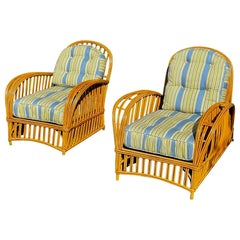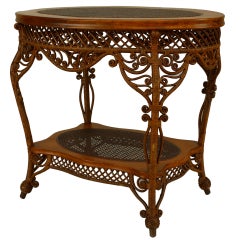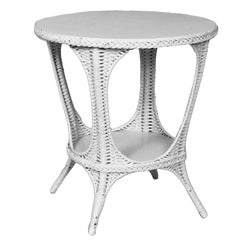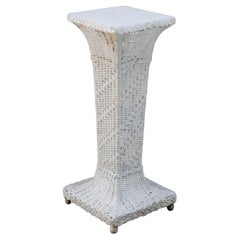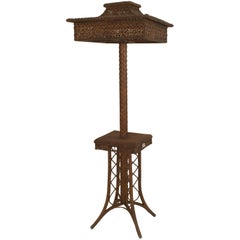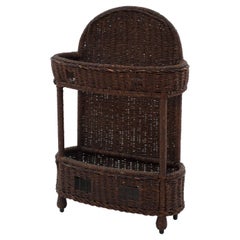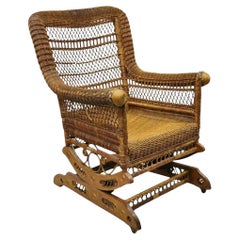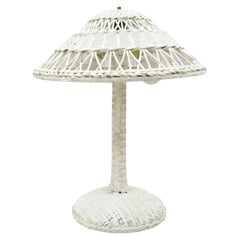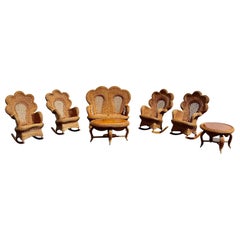Wakefield Furniture Antique
1920s American Art Deco Wakefield Furniture Antique
Upholstery, Wicker, Rattan, Reed
19th Century American Victorian Wakefield Furniture Antique
Wicker
Late 19th Century American Victorian Wakefield Furniture Antique
Wicker, Wood
Early 20th Century Arts and Crafts Wakefield Furniture Antique
Wicker
19th Century American Victorian Wakefield Furniture Antique
Wicker
Late 19th Century American Victorian Wakefield Furniture Antique
Wicker, Wood
Late 19th Century Unknown Victorian Wakefield Furniture Antique
Wicker
Early 20th Century Unknown Arts and Crafts Wakefield Furniture Antique
Wicker
Early 20th Century Victorian Wakefield Furniture Antique
Wicker, Wood
Late 19th Century American Victorian Wakefield Furniture Antique
Wicker
19th Century American Wakefield Furniture Antique
Giltwood
Early 1900s American Late Victorian Wakefield Furniture Antique
Wicker
Late 19th Century Wakefield Furniture Antique
Wicker, Paint
1920s American Art Deco Wakefield Furniture Antique
Fabric, Hickory
1910s American Arts and Crafts Wakefield Furniture Antique
Wicker
Late 19th Century American Aesthetic Movement Wakefield Furniture Antique
Wicker, Oak
1890s American Victorian Wakefield Furniture Antique
Wicker, Beads
1920s American Art Deco Wakefield Furniture Antique
Wicker, Rattan, Reed
1890s American Late Victorian Wakefield Furniture Antique
Metal
Early 20th Century American Wakefield Furniture Antique
Wicker
Late 19th Century American Late Victorian Wakefield Furniture Antique
Wicker
Mid-19th Century American Victorian Wakefield Furniture Antique
Metal
1920s American Art Deco Wakefield Furniture Antique
Wicker, Rattan, Reed
1920s American Art Deco Wakefield Furniture Antique
Upholstery, Wicker, Rattan, Reed, Wood
Early 20th Century American Other Wakefield Furniture Antique
Upholstery, Wicker, Reed, Wood
Late 19th Century American Wakefield Furniture Antique
Fabric, Wicker
Early 20th Century Wakefield Furniture Antique
Wicker
Late 19th Century American American Classical Wakefield Furniture Antique
Sterling Silver
Early 1800s English George III Wakefield Furniture Antique
Canvas
Early 1900s American Edwardian Wakefield Furniture Antique
Leather, Wicker
19th Century American Victorian Wakefield Furniture Antique
Oak, Wicker
Early 20th Century Wakefield Furniture Antique
Oak, Paint
Late 19th Century American Victorian Wakefield Furniture Antique
Wicker, Rattan, Reed, Wood
1890s American Art Nouveau Wakefield Furniture Antique
Wicker, Cane, Reed, Wood
1920s American Art Deco Wakefield Furniture Antique
Upholstery, Wicker, Rattan, Reed, Wood
1910s American Other Wakefield Furniture Antique
Upholstery, Wicker, Reed, Wood
Early 20th Century American Other Wakefield Furniture Antique
Upholstery, Wicker, Reed, Wood
1910s American Other Wakefield Furniture Antique
Upholstery, Wicker, Reed, Wood
1920s American Art Deco Wakefield Furniture Antique
Upholstery, Wicker, Rattan, Reed
1890s American Edwardian Wakefield Furniture Antique
Wicker, Cane, Wood
Early 20th Century American Art Deco Wakefield Furniture Antique
Wicker
1910s American Arts and Crafts Wakefield Furniture Antique
Wicker, Rattan, Reed, Wood, Oak, Paint
1910s American Arts and Crafts Wakefield Furniture Antique
Wicker, Rattan, Reed, Wood, Oak, Paint
Early 1900s American Art Nouveau Wakefield Furniture Antique
Wicker, Cane, Reed
1890s American Victorian Wakefield Furniture Antique
Wicker, Reed, Wood
Early 19th Century English Wakefield Furniture Antique
Leather, Paint, Paper
Early 20th Century American Arts and Crafts Wakefield Furniture Antique
Oak
Late 19th Century American Victorian Wakefield Furniture Antique
Wicker
Early 20th Century American Arts and Crafts Wakefield Furniture Antique
Brass
Late 19th Century Unknown Wakefield Furniture Antique
Wicker, Rattan, Wood
1910s American Arts and Crafts Wakefield Furniture Antique
Upholstery, Wicker, Reed, Wood
1920s American Art Deco Wakefield Furniture Antique
Upholstery, Wicker, Reed, Wood
Early 20th Century American Arts and Crafts Wakefield Furniture Antique
Oak
1920s American Art Deco Wakefield Furniture Antique
Wicker, Rattan, Reed, Wood
Early 20th Century American Arts and Crafts Wakefield Furniture Antique
Wicker, Reed, Wood
1920s American Art Deco Wakefield Furniture Antique
Upholstery, Wicker, Rattan, Reed, Wood
Early 20th Century American Victorian Wakefield Furniture Antique
Wicker
1890s American Victorian Wakefield Furniture Antique
Wicker
- 1
Wakefield Furniture Antique For Sale on 1stDibs
How Much is a Wakefield Furniture Antique?
- 1stDibs ExpertFebruary 1, 2024To identify Heywood-Wakefield furniture, search for the maker's mark. You will typically find it on a paper label or stamped directly onto an inconspicuous part of the piece, such as under the seat or tabletop. Early pieces usually display the company's name on its own, while those manufactured after 1949 will often have an eagle logo along with the Heywood-Wakefield wordmark. If questions about authentication remain, a certified appraiser or experienced antiques dealer can assist you. Explore a diverse assortment of Heywood-Wakefield furniture on 1stDibs.
- 1stDibs ExpertApril 5, 2022Heywood-Wakefield furniture is an American brand founded in 1897. The mid-century modern furniture manufacturer uses sustainable, durable Northern Yellow birch, which gives its pieces a rich yellow color. Shop a collection of Heywood-Wakefield furniture from some of the world’s top sellers on 1stDibs.
- 1stDibs ExpertApril 5, 2022Yes, Heywood-Wakefield uses solid wood to create its furniture. The lumber used for the designs is sustainable and harvested from farms in New Hampshire. You can shop a collection of Heywood-Wakefield furniture from some of the world’s top sellers on 1stDibs.
- 1stDibs ExpertFebruary 13, 2023Heywood-Wakefield started making furniture in 1897. The company formed from the merger of two rattan furniture manufacturers, Heywood Brothers and Wakefield Company. Both companies were in Massachusetts. On 1stDibs, find a collection of Heywood-Wakefield furniture.
- 1stDibs ExpertFebruary 13, 2023Heywood-Wakefield furniture was made from a variety of woods. However, the furniture maker's acclaimed blond wood casegoods were made from birch and maple wood. On 1stDibs, find a selection of Heywood-Wakefield furniture.
- Is antique furniture in style?1 Answer1stDibs ExpertApril 22, 2024Yes, antique furniture is in style. Many people appreciate the beauty and handcrafted character of antique furniture and love the idea of owning pieces with a rich history. Remember that style preferences are nothing if not fluid, meaning what's in one year may not be the next. So, in choosing the furniture you're planning to live with, you should pay less attention to interior design fads than to what speaks to you. That way, you can select pieces that will add long-term character to your home. On 1stDibs, find a large collection of antique furniture.
- 1stDibs ExpertMay 30, 2024To identify your antique furniture, look for an engraving, tag, label or other marking that indicates who produced it. You may find it on the bottom or back of your furniture or inside a drawer or cabinet. Once you have located the marking, you can snap a photo of it and use a reverse image search to try and identify the maker. Or, you can type a description of the mark into a search engine. Alternatively, you can use the services of a certified appraiser or antiques dealer to get assistance with identification. On 1stDibs, shop a large selection of antique furniture.
- What makes furniture an antique?1 Answer1stDibs ExpertAugust 15, 2019
A piece of furniture is considered an antique if it is at least 100 years old.
- 1stDibs ExpertMay 14, 2024Many antique furniture brands are popular. While trends in collecting do vary over time, some makers consistently remain highly sought after. Among them are J. & J.W. Meeks, John Henry Belter, R. J. Horner and Co., Stickley Furniture, George Hepplewhite, Josef Dannhauser, Thomas Chippendale and Thomas Sheridan. On 1stDibs, shop a variety of antique furniture.
- 1stDibs ExpertApril 5, 2024To know if your furniture is antique, look for labels and markings that indicate the maker. From there, you can use trusted online resources to determine when they were active and examine images to try to estimate the age of your piece. Furniture produced 100 years ago or more is antique. You can also have your furniture assessed by an appraiser or antiques dealer to learn about its age. On 1stDibs, explore a large collection of antique furniture.
- 1stDibs ExpertFebruary 22, 2021Antique furniture can be worth quite a lot, particularly if it is in good quality. The rarer the piece, the higher the value.
- 1stDibs ExpertFebruary 13, 2024Whether antique furniture is making a comeback is a matter of opinion. Many people would argue that antique furniture never faded from fashion, as there have always been individuals who love the idea of owning pieces that have history. Some of the most popular styles for antique furniture include Art Deco, Arts and Crafts, Renaissance Revival, Elizabethan, Gothic Revival, Victorian and Chippendale. Find a large collection of antique furniture from some of the world's top dealers on 1stDibs.
- 1stDibs ExpertFebruary 1, 2024To date antique furniture from the UK, first look for identifying markings on the piece. You can then use trusted online resources to determine when the maker was active. From there, you may be able to estimate the year of production by looking at images of other furniture the maker produced. An expert appraiser or antiques dealer can also aid you in the dating process. Find a large selection of antique furniture on 1stDibs.
- 1stDibs ExpertFebruary 22, 2021There are a number of factors that can indicate if your antique furniture is valuable. When determining the value of antique furniture, consider its rarity. Additionally, it is important to determine the quality and condition of vintage furniture. If unsure of the value of your vintage furniture, have it appraised.
- 1stDibs ExpertNovember 4, 2024To identify antique Chinese furniture, look carefully at its details. Chinese craftsmen often built furniture using mortise and tenon joinery, eliminating the need for nails and screws. If you see this type of hardware, your piece is likely not at least 100 years old, especially if the hardware still looks new and shiny. Since antique furniture was handmade, you will normally see slight imperfections, such as tool marks or slight variations in carvings. Pieces that appear completely uniform and pristine are less often genuine antiques.
When present, maker's marks can also be helpful. Research the marks to learn more about when the maker was active and producing pieces like yours. Alternatively, you can have a certified appraiser or experienced antique dealer evaluate your furniture for you.
Shop an assortment of antique Chinese furniture. - 1stDibs ExpertOctober 5, 2021The best finish for antique furniture is a matter of liking. But film finish is recommended by experts as it leaves a thick coat of film on the wood surface which protects wood from water and scratches. Shellac or varnish and water base are commonly used film finishes. Find an exquisite collection of antique, new and vintage furniture on 1stDibs
 PAGODA REDOctober 7, 2020
PAGODA REDOctober 7, 2020To determine the age of a Chinese furniture piece, look carefully at the joinery and finish. Natural expansion and contraction of the wood over time will cause a joint to protrude or retract, distorting a once-seamless fit. Antique lacquer finishes become crackled and worn over time. Areas of exposed wood, such as the underside of a table, the footrest of a chair, or the back of a cabinet should appear raw and dry compared to the finished surface. With use, the legs of tables and chairs become weathered near the bottom from precipitation and use.
- 1stDibs ExpertAugust 29, 2024To tell how old your antique furniture is, research the maker using trusted online resources. You may find that the furniture maker was active for only a short period, giving you the ability to roughly estimate its age. For manufacturers and designers with a long history of production, consider the style of your furniture and look for images of similar pieces published online. Because it may be difficult to date furniture on your own, consider consulting a certified appraiser or knowledgeable antique dealer. On 1stDibs, explore a variety of antique furniture.
- 1stDibs ExpertAugust 20, 2024To tell what your antique furniture is worth, look at sales histories on trusted online platforms and read valuation guides posted on trusted online resources. The maker, type, style, age and condition of your furniture will impact its value. Researching furniture produced by the same maker is a good starting point. A certified appraiser or knowledgeable antique dealer can also aid you in the valuation process. Find a large collection of antique furniture on 1stDibs.
- 1stDibs ExpertNovember 13, 2024How old furniture that is called antique can be is typically at least 100 years. People usually call furniture between 20 and 99 years old vintage. Contemporary is the word for furniture manufactured within the last 20 years. On 1stDibs, shop a large selection of antique, vintage and contemporary furniture from some of the world's top sellers.
